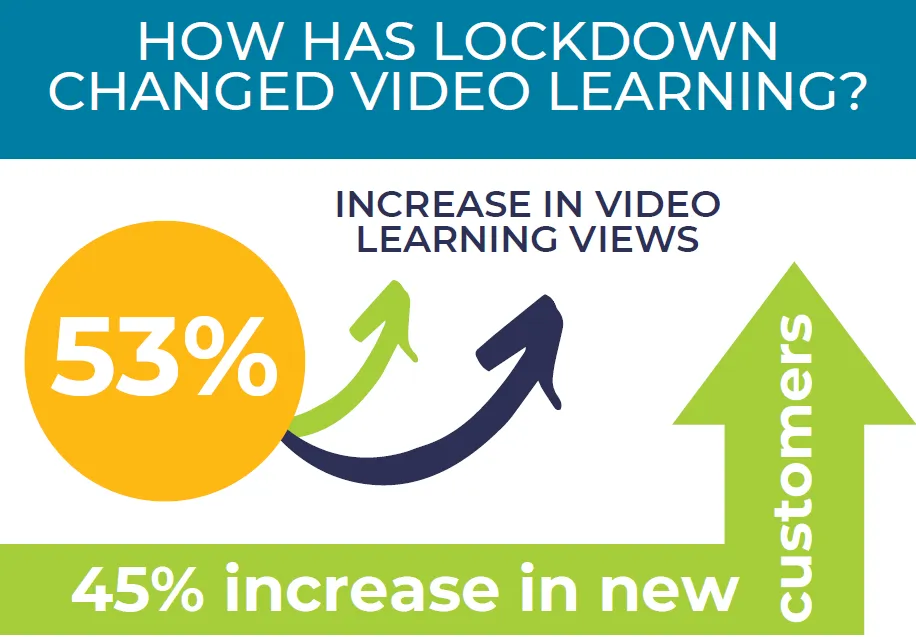
Scott Bradbury reports on its clients’ video learning usage before and after the lockdown and provides useful benchmark data for you to compare with your own experiences. WATCH & GO® is Scott Bradbury’s proprietary video learning platform, which streams the company’s videos on soft skills topics directly to learners.4-minute read.
Increased demand for video learning has been widely reported recently in the HR press and much has been said about the positive benefits of using video for online learning during the coronavirus pandemic. But has lockdown really changed video learning habits?
Now that the immediate fall-out from Covid-19 has been addressed, and everyone braces for an unpredictable winter of living with the virus, learning departments across the country are focusing on updating their online learning provision. And it appears that video content is proving a popular and key ingredient in the mix.
Conversations with leading HR and Learning & Development professionals indicate a serious interest in using video to provide much-needed instant support. And many are seeking to replace programmes previously delivered face-to-face with video-based learning. For example, one university in the north east of England is transforming its ‘Into Management’ fundamentals programme into a series of online video-based short modules, now known as the ‘Into Management Video Learning Pathway.’
53% increase in video learning
With employees working from home, and often during unusual hours, the emphasis has been on providing instant support whenever and wherever needed. In addition, senior management has frequently required most, if not all, learning to be put online and it’s not surprising therefore, that people are turning to video. Its easy accessibility and universal appeal make it an obvious go-to resource.
Data from our clients’ WATCH & GO video learning sites show a 53% increase in video views when the three-month periods immediately before and after lockdown on 23 March 2020 are compared.
Increased demand for video viewing resulted in enquiries from new customers wanting to introduce video for the first time or enhance existing video provision. And the growing popularity of video for learning is reflected in a big increase in new WATCH & GO video learning clients.
The number of subscribers in July 2020 was 45% up compared with subscribers in July 2019. And what is particularly interesting about this is that the new intake of customers has changed the rankings of our most popular video titles. So out go traditional titles on topics like coaching and performance management and straight in at the top spots come videos like ‘Concentration Skills for Busy People’, ‘Dealing with Distractions’ and ‘Working in Uncertain Times’. All areas which have been sorely tested during lockdown.
The viewing habits of our established clients however told a different story. Titles relating to coaching, feedback and change management remained defiantly within the top five videos viewed. Perhaps that’s not so surprising after all because they provided some much-needed consistency in a sea of change. And these were long-running online programmes which had the opportunity to flourish when employees were furloughed and could learn, even if they couldn’t work.
One thing that hasn’t changed
Curiously, when we look at the data, we find some things don’t change. The most obvious of these is the use of learning device. Despite the many changes in working practices over recent months, the most common way to consume our online videos is via a desktop computer. The much-heralded fad of ‘m-learning’ never really took off. And whilst its perfectly possible to watch videos for learning on mobile devices, even when you add mobile phone and tablet viewing together, our results show that they still only account for 21% of the views. So, the vast majority of online learning is still done at the desktop computer, regardless of the convenience of mobile accessibility. It’s another example of the 80:20 Pareto principle!
We also find that the day of the week which is most popular for learning is consistently during mid-week, typically a Tuesday. If you want people to watch a video, try asking them to do it on a Tuesday! Why? Perhaps the week is still young enough for learners to feel there’s time to accomplish something new, whilst not being overwhelmed by the demands of the start of a new week.
How do different sectors compare?
With our subscriber organisations coming for a wide variety of sectors including Education, Financial Services, Local Government, Housing, Charities and Healthcare, the data doesn’t reveal any obvious differences in the viewing habits of their learners. The demand for video learning is right across the board, and whilst different sectors will have specific learning requirements, video titles on management, communication, and personal effectiveness topics are appealing to learners across all sectors.
What’s next?
Covid-19 and the resulting lockdown has undoubtedly brought change. And many are predicting that the workplace will never return to the way it was before the pandemic. Organisational Learning and Development must change fast too.
Have the repercussions of Covid-19 changed video learning for good, too? What we’ve undoubtedly seen is a faster pace of change as organisations which previously had underdeveloped online provision rush to adapt face-to-face delivery for online consumption. Some - although by no means all - of that training may, in time, return to the classroom. But the demand for online video learning to provide instant, easily accessible support is unlikely to diminish. Change is always with us. And there are videos on that too!
Video learning will continue to evolve and the benefits of quality, relevant and timely video learning are here to stay. At least for now. And that’s good for everyone!
Further Reading:
https://www.peoplemanagement.co.uk/long-reads/articles/covid-19-caused-learning-development-revolution
https://www.fosway.com/research/next-gen-learning/covid19-research/
https://www.thehrdirector.com/business-news/press-release/covid-19-is-providing-a-needed-revolution-to-the-learning-industry/
https://www.trainingzone.co.uk/lead/culture/why-the-reinvention-of-ld-post-covid-19-must-start-with-learning-culture